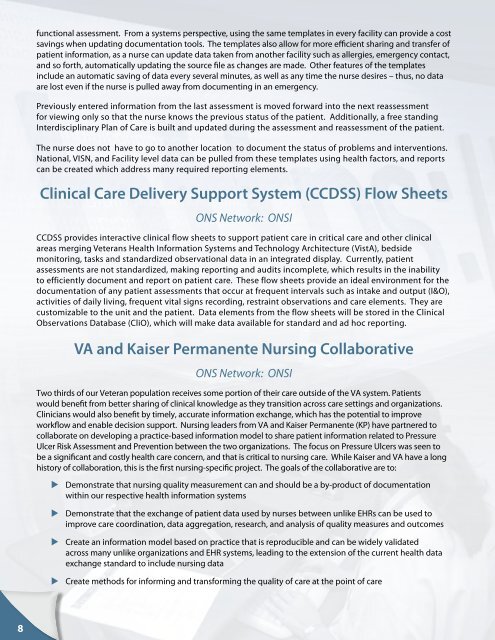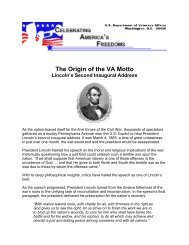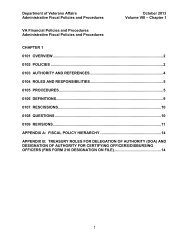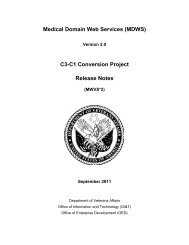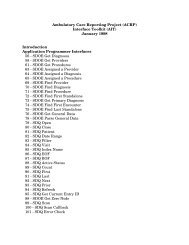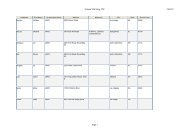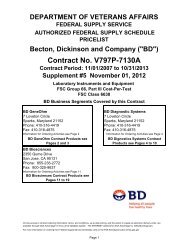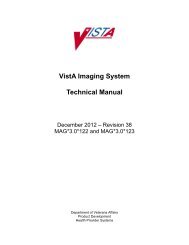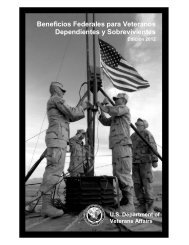ONS Annual Report 2010 - US Department of Veterans Affairs
ONS Annual Report 2010 - US Department of Veterans Affairs
ONS Annual Report 2010 - US Department of Veterans Affairs
Create successful ePaper yourself
Turn your PDF publications into a flip-book with our unique Google optimized e-Paper software.
8<br />
functional assessment. From a systems perspective, using the same templates in every facility can provide a cost<br />
savings when updating documentation tools. The templates also allow for more efficient sharing and transfer <strong>of</strong><br />
patient information, as a nurse can update data taken from another facility such as allergies, emergency contact,<br />
and so forth, automatically updating the source file as changes are made. Other features <strong>of</strong> the templates<br />
include an automatic saving <strong>of</strong> data every several minutes, as well as any time the nurse desires – thus, no data<br />
are lost even if the nurse is pulled away from documenting in an emergency.<br />
Previously entered information from the last assessment is moved forward into the next reassessment<br />
for viewing only so that the nurse knows the previous status <strong>of</strong> the patient. Additionally, a free standing<br />
Interdisciplinary Plan <strong>of</strong> Care is built and updated during the assessment and reassessment <strong>of</strong> the patient.<br />
The nurse does not have to go to another location to document the status <strong>of</strong> problems and interventions.<br />
National, VISN, and Facility level data can be pulled from these templates using health factors, and reports<br />
can be created which address many required reporting elements.<br />
Clinical Care Delivery Support System (CCDSS) Flow Sheets<br />
<strong>ONS</strong> Network: <strong>ONS</strong>I<br />
CCDSS provides interactive clinical flow sheets to support patient care in critical care and other clinical<br />
areas merging <strong>Veterans</strong> Health Information Systems and Technology Architecture (VistA), bedside<br />
monitoring, tasks and standardized observational data in an integrated display. Currently, patient<br />
assessments are not standardized, making reporting and audits incomplete, which results in the inability<br />
to efficiently document and report on patient care. These flow sheets provide an ideal environment for the<br />
documentation <strong>of</strong> any patient assessments that occur at frequent intervals such as intake and output (I&O),<br />
activities <strong>of</strong> daily living, frequent vital signs recording, restraint observations and care elements. They are<br />
customizable to the unit and the patient. Data elements from the flow sheets will be stored in the Clinical<br />
Observations Database (CliO), which will make data available for standard and ad hoc reporting.<br />
VA and Kaiser Permanente Nursing Collaborative<br />
<strong>ONS</strong> Network: <strong>ONS</strong>I<br />
Two thirds <strong>of</strong> our Veteran population receives some portion <strong>of</strong> their care outside <strong>of</strong> the VA system. Patients<br />
would benefit from better sharing <strong>of</strong> clinical knowledge as they transition across care settings and organizations.<br />
Clinicians would also benefit by timely, accurate information exchange, which has the potential to improve<br />
workflow and enable decision support. Nursing leaders from VA and Kaiser Permanente (KP) have partnered to<br />
collaborate on developing a practice-based information model to share patient information related to Pressure<br />
Ulcer Risk Assessment and Prevention between the two organizations. The focus on Pressure Ulcers was seen to<br />
be a significant and costly health care concern, and that is critical to nursing care. While Kaiser and VA have a long<br />
history <strong>of</strong> collaboration, this is the first nursing-specific project. The goals <strong>of</strong> the collaborative are to:<br />
� Demonstrate that nursing quality measurement can and should be a by-product <strong>of</strong> documentation<br />
within our respective health information systems<br />
� Demonstrate that the exchange <strong>of</strong> patient data used by nurses between unlike EHRs can be used to<br />
improve care coordination, data aggregation, research, and analysis <strong>of</strong> quality measures and outcomes<br />
� Create an information model based on practice that is reproducible and can be widely validated<br />
across many unlike organizations and EHR systems, leading to the extension <strong>of</strong> the current health data<br />
exchange standard to include nursing data<br />
� Create methods for informing and transforming the quality <strong>of</strong> care at the point <strong>of</strong> care


